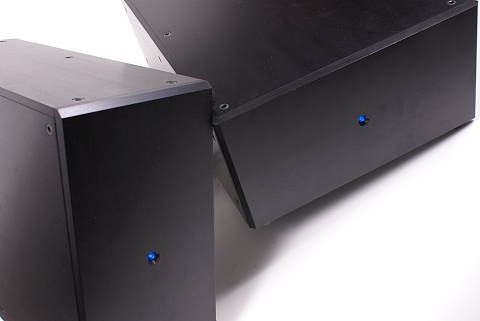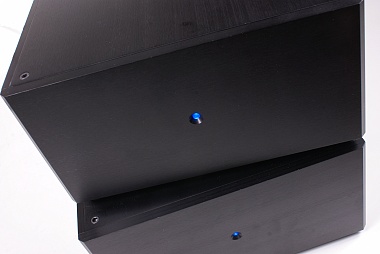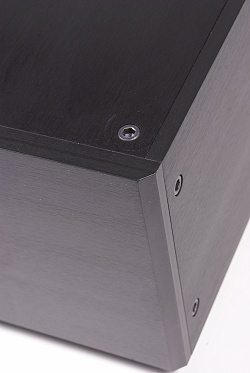

|
| // Main page | // Construction Philosophy | // FAQ | // Synopsis | // Exhibitions | // Reviews | // Contact |
|
|

Arion Audio MK 1000Most possibly you haven't heard yet about the "Arion Audio".The truth is neither we had, until we faced the two austere MK 1000 monoblock that became one of the most pleasant surprises of the last months. Class D with signal to noise ratio -116dB, is feasible? Finally yes. Page 1ReviewArion Audio MK 1000
You would have noticed, that at the introduction, the power output of the MK 1000 is not particularly mentioned. Actually, it is the most powerful amplifier we have tested until today giving more than 500W at 8 Ohm load with the capability to double its power at 4 Ohm (we measured till 940W). Though this is something expected from this device for two reasons. Firstly, it is an amplifier with output stage at class D and switching power supply, something that plainly means that it can provide high power without any of the issues of the linear type amplifiers (meaning without monstrous transformers, very priced coolers and the need of four persons to carry it at the first floor) and secondly, Arion Audio is the sister company of Analysis at the USA. Since these people are designing loudspeakers with sensitivity no more than 86dB, it is reasonable that they would take care to construct also the appropriate amplifiers. Impressing was the extremely low amplifier's noise and how it's performance seems unaffected by the familiar function principle of switching elements with the high frequency signal that arises complications. Well, first thing first: Arion Audio is a new company, affiliated with the Greek Analysis Audio. The MK 1000 is the first of the Arion planed series. According to our info, this series will include a smaller monoblock of 250W/8Ohm as well as a hybrid amplifier with tube input and switching output stage. Let's now see the details... Page 2
The MK 1000 is a very spartan construction that is based on thick aluminum plate (6mm at the sides and 9.5mm at the faceplate) simply assembled in a very robustcase. The phase plate has one led that functions as on-off and overload indicator ( anyway we havenít ever seen it indicating overload...) while at the back side exist the absolutely necessary, namely the amplifier's input in single ended and as well as in balanced form, the loudspeaker's binding posts and an on-off switch. The binding post's quality is very good, of gold plated solid copper (Gold over Solid Copper) made by Cardas.
As it is obvious from the photos the amplifier is dimensionally small with width of no more than 25cm and depth a litle more than 35, while its weight is small, just 9Kg. Arion mentions that it may be placer vertically if needed a small floor print, this ability could be welcomed to someone wishing to place the amplifier close to the loudspeaker. For reasons that will appear at the next pages (particularly at the measurement's page) the device's internal would be much more interesting than the external. I do write "would be" because unfortunately Arion chose the secrecy regarding the schematic design of the MK 1000, giving none written detail and -mainly- covering anything under a non transparent green material. We tried through the Analysis Audio to access on some details but it became obvious that, at least at this moment, the Arion is not willing to explain the interior of their amplifiers. Disappointing but respectable.
What is seen inside the MK 1000 is, firstly, the very thorough shield of the power supply, a printed circuit board with SMD components that obviously includes the output circuitry and some cabling that seems somehow..."loose" but as we reed at the company's description, specifically for the inputs, it is especially designed for the purpose from Arion itself, while the power cable that accompanies the amplifiers is from JPS Labs. The amplifier does not use visible coolers and it is supposable on what it is seen at the interior, that it uses the chassis sides for heat dissipation.
Page 3
At the laboratory measurements, the MK 1000 was impressing. Firstly confirmed the constructor's allegations, by delivering 524Wrms at 8 ohm load, that was elevated at 940Wrms when the load became 4 Ohms. With a power increase factor of 1.79 and at that high power, the amplifier is very adequate for low sensitivity loudspeakers that also are difficult as a load. The sensitivity appeared somehow low, as it needs 3.54Vrms for full power. The frequency response with Ohmic load and reference power the 100W/8Ohm is practically flat with minimal deviations at the ends, that are less than 0.7dB at 10Hz and 0.2dB at 40KHz. The two amplifiers proved extremely similar with their utmost difference at 0.25dB at the 30-40-KHz region, while into the audio spectrum the difference was even smaller. The very good behaviour persisted with a complex load that mimics loudspeaker's load, with equally very small deviations at very low frequencies and with a very gentle down slope (-0.25dB)to appear above 2KHz. The dubbing factor calculated at 334. The MK 1000 distortions lied at very low levels at static condition measurements 0.0047% for the harmonic distortion and 0.0040% for the intermodulation distortion, both at output power of 175W/8Ohm.The harmonic distortion versus frequency graph, showed smooth behaviour that was from 0.003% at most of the audio spectrum with an upward tendency until 0.009% towards the high frequencies, for power 100Wrms/8Ohm and even smoother behaviour, at 0.02% for 100W/4Ohm. At the versus power measurements we got the usual curves with the ends lying a little higher than the rest area. At 10Wrms the shown figures are 0.009% for 8Ohm load and 0.02% for 4Ohm, with the amplifier easily exceeding 500W before reaching the formal level of 0.3% at 8Ohm and the 900W at 4Ohm confirming the static power measurement. The spectrum with signal of 1KHz (10Wrms/8Ohm) shows components at very low levels ( about and under -100dB) that decrease as the frequency increase. The noise at the low frequencies is very low, with an only exception at 50Hz, though at the hies, over 10KHz seems somehow higher but lies at the region -120 to -140 under the fundamental.
The static noise measurements was the best we have seen and surely the best from an amplifier with switching output stage, till now. With reference of 0.1Wrms/8Ohm we measured -116dB(A), a figure that confirmed the constructor's allegation and is really very low. The "quietness" of the output stage clearly also shows the noise spectrum with shorted input (and reference level the 0.1Wrms/8Ohm). It seems that over 20KHz the spectrum upscale but still lies at very low level. It worth to be mentioned that due to the very good behaviour of the amplifier the measurements was done without the use of special filter that is normally required for the switching amplifiers measurements. Measurements tableMaximum power (1KHz, 0.3% THD+N, 8Ohm) 524WrmsMaximum power (1KHz, 0.3% THD+N, 4Ohm) 940Wrms Increase factor 1.79 Sensitivity (for maximum power) 3.54Vrms Dabbing factor 334 THD+N (1KHz, 1/3 Pmax, 8Ohm) 0.0047% IMD (1KHz, 1/3 Pmax, 8Ohm) 0.0040% S/N ratio (1KHz , 0.1Wrms, 8Ohm) -116dBr(A) Page 4The two MK 1000 called to replace the reference amplifier ( Parasound HCA3500) and to drive the ATC SCM-50 PSL. The preamplifier was the usual Melos Plus Series line with source from the Teac Esoteric P70/D70, sometimes supported by the dCS Debussy that was at about the same time at the system. The first impression that someone has by listening the MK 1000 is that of a cool power ( I remind that the listening is forego the measurements for three reasons: firstly for not to arise unnecessary biases from a very good behaviour at the lab, secondly to leave enough time for the investigation of what would be found at the listening and thirdly -and most important- for not to waste time in case that the amplifier fall during the measurements and need of repair or replacement, therefore I didnít knew how quiet it was when I listened it). The amplifier seemed completely controlling the loudspeaker and in every case, possessing significant driving reservoir and at the same time offering neutrality and very low noise.
The ATC SCM 50 withstands high power and could provide even 112dBSPL at one meter, so I used the opportunity to use the grate reservoir of the amplifiers. What I got was very high levels ( certainly higher than the space's limiting level) but without the slightest compression problem or displeasing hue. During these exploring listening I saw 102dBSPL at the listening place that is about 2.8 meters from the loudspeakers and I haven't the slightest desire to turn the volume lower, regardless of the programs type and I mention that because the subjective feeling of volume differentiates significantly from the measurement of volume and is closely correlated with the program contend. Hereupon, the MK 1000 didn't showed the slightest preference on plays with a few instruments and with demand for extended dynamic region, they flawlessly projected the music over a very silent background, describing perfectly the small details and realistically transferring the dynamics of the recording while the plays with great energy and smaller demands in dynamic range (like the electronic music with the continuant loupes and the arpeggios) where reproduced relaxed and at levels that permitted you to enter the synthesis, follow it and finally to enjoy it. 
The amplifiers proved extremely neutral with great describing capabilities at the very low ( noticeably superior than the reference amplifier), a performance that became more obvious from the way that the system amplifiers/loudspeakers coped the equalization imposed by the Copland DRC-205. The volume of the instruments of that spectral area was very good and the transparency of the system allowed a lot details to emerge. The mid are appeared composed, without overstatement and with describing capability of the human voice with the chorus having realistic dimensions and very live presence into the space. At the high frequencies I got transparency and very good timing attributes. The MK 1000 sounds, firstly, somehow simplistic at the description of the body of small metallic percussion and wind instruments but in reality I finally kept the impression that it is austere, without euphonic behaviour or other coloration problems. Finally the saneness of the two monoblocks of the pair that was seen at the measurements, plays its role at the stereophonic image. The amplifiers created stable sound stage, with plenty details in the depth axon and good width while proved capable to accent the character of the rest system emerging with characteristic easiness the differences produced by the external clocking of the Teac Esoteric P70 and the dCS Debussy through the Puccini U-Clock. Finally......there is no doubt that the MK 1000 from Arion Audio has all the prerequisites to become a big success and this for three reasons: Firstly they have neutrality and very low noise despite their very high power, secondly they do deliver -exactly- that high power that will free them who have a difficult loudspeaker and/or big space and third they achieve all these at a comparatively reasonable cost. Clearly we have a preposition that will place at the corner a lot of the big names and that someone who is about to buy a powerful amplifier should probe very carefully. Also notice the bonus of your back comfort when you should carry them and you will neither need a new air-condition for your living room! If we only knew how do they do it...D. Stamatakos |
 e mail to Analysis
e mail to Analysis